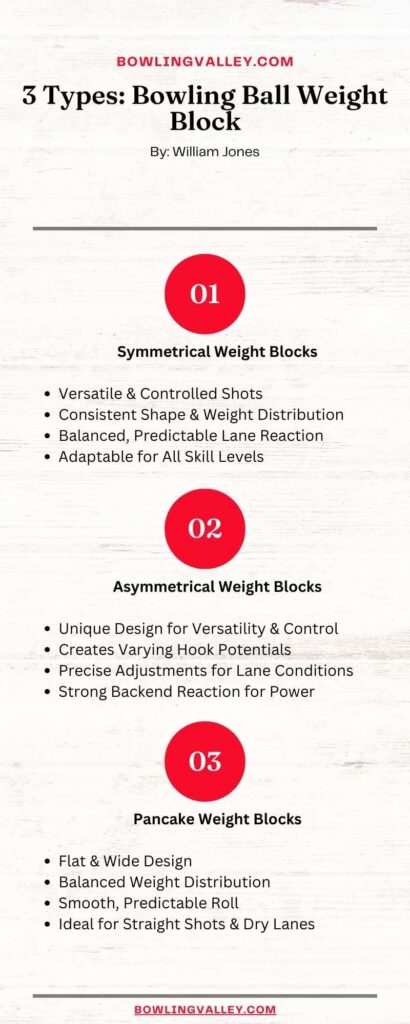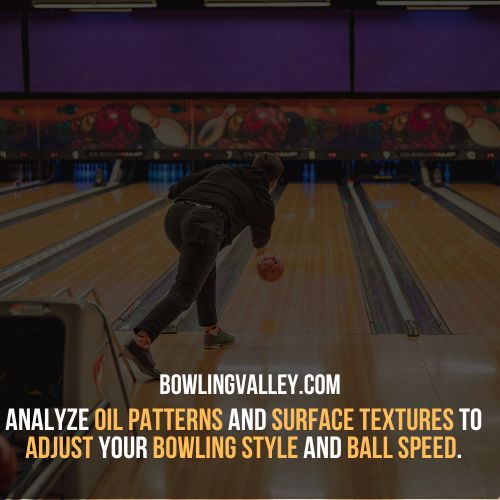“Bowling Ball Weight Block” – This little piece of magic inside the ball helps to distribute weight and give you the freedom to throw with ease.
It is a core component inside a bowling ball that influences its overall weight distribution and performance on the lanes. It is typically made of a dense material such as urethane or resin and is designed to create a specific ball motion.
In today’s article, we’ll explore the different types of weight blocks and help you choose the perfect one for your bowling style.
Jump to a Specific Section
- 1 The Purpose of Bowling Ball Weight Blocks
- 2 3 Types of Weight Blocks: Symmetrical, Asymmetrical, and Pancake
- 3 How to Choose the Right Weight Block for Yourself?
- 4 Closing Thoughts
- 5 Frequently Asked Questions
- 5.1 Are Weight Blocks Only Found in High-Performance Bowling Balls?
- 5.2 Can Weight Blocks Be Customized or Adjusted in a Bowling Ball?
- 5.3 Do Weight Blocks Affect the Hook Potential of a Bowling Ball?
- 5.4 Are Weight Blocks Equally Important for Beginners and Advanced Bowlers?
- 5.5 Can Weight Blocks Be Removed or Replaced in a Bowling Ball?
- 6 Resources Used for Research
The Purpose of Bowling Ball Weight Blocks
The purpose of a bowling ball weight block is to provide stability and control to your bowling ball’s motion down the lane.
It acts as the core of the ball, influencing its overall performance.
Adjusting the weight distribution of your bowling ball’s weight block allows you to customize the ball’s reaction to match your playing style and lane conditions.
It plays a crucial role in determining how the ball will react when thrown down the lane.
By altering its position and shape, you have the freedom to fine-tune your ball’s performance.
3 Types of Weight Blocks: Symmetrical, Asymmetrical, and Pancake
Now let’s talk about the different types of weight blocks used in bowling balls.

1. Symmetrical Weight Blocks
Ideal for versatile and controlled shots, symmetrical weight blocks maintain a consistent shape and weight distribution.
This results in a balanced and predictable reaction on the lanes. Whether you’re a beginner or seasoned bowler, this design allows you to adapt to various angles without sacrificing control, providing a smooth, even arc.
2. Asymmetrical Weight Blocks
Offering a unique design for enhanced versatility and control, asymmetrical weight blocks create varying hook potentials with their offset shape.
This flexibility allows precise adjustments for different lane conditions, making them advantageous on challenging oil patterns.
With a stronger backend reaction, these weight blocks deliver an aggressive and dynamic response, perfect for bowlers seeking a powerful ball reaction.
3. Pancake Weight Blocks
Distinguished by their flat and wide shape, pancake weight blocks provide a balanced weight distribution from the center of the ball.
This design ensures a smooth and predictable roll, granting bowlers control over the ball’s motion.
Ideal for straight shots and dry lane conditions, it empower players to confidently showcase their skills and adapt to various bowling scenarios.
How to Choose the Right Weight Block for Yourself?
When choosing the right weight block for yourself, there are several important factors to consider.
| Factor | Scenario | Recommended Weight Block |
| Hook Potential | High hook potential | Asymmetrical weight block with higher differential coefficient |
| Hook Potential | Lower hook potential | Symmetrical weight block with lower differential coefficient |
| Ball Speed | High rev rate | Lower differential coefficient (DC) |
| Ball Speed | Lower rev rate | Higher differential coefficient |
| Lane Conditions | Heavy oil | Asymmetrical weight block with higher differential coefficient |
| Lane Conditions | Dry lanes | Symmetrical weight block with lower differential coefficient |
| Hand Size | Larger hands | Larger grip diameter |
| Hand Size | Smaller hands | Smaller grip diameter |
| Desired Ball Reaction | Aggressive hook | Asymmetrical weight block with higher differential coefficient |
| Desired Ball Reaction | Smoother roll | Symmetrical weight block with lower differential coefficient |
| Rev Rate | High rev rate | Bowlers with high rev rates may find lower differential coefficients (DC) more suitable to control excessive hook. |
| Rev Rate | Lower rev rate | Bowlers with lower rev rates may benefit from higher differential coefficients to enhance hook potential and achieve desired backend motion. |
| Lane Conditions | Heavy oil | Bowlers encountered oily lanes may use asymmetrical weight blocks with higher differential coefficients to provide the necessary hook potential to break through the oil and achieve backend motion. |
| Lane Conditions | Dry lanes | Bowlers bowling on dry lanes may find symmetrical weight blocks with lower differential coefficients more suitable to control the ball’s motion and prevent excessive hook |
Assessing Your Bowling Style, Ball Speed, and Lane Conditions
First, evaluate your bowling style by understanding your hook potential and how it affects your shots.
Next, gauge your ball speed by measuring your rev rate and observing your ball’s reaction on the lane.
Finally, analyze the lane conditions by identifying the oil patterns and surface textures, which can impact your ball’s performance.
Evaluating Your Bowling Style: Understanding Your Hook Potential
To accurately assess your bowling style, evaluate your hook potential by considering factors such as ball speed, lane conditions, and your individual preferences.
Understanding your hook potential is crucial in choosing the right weight block for yourself.
- High Hook Potential: Bowlers with high hook potential may benefit from asymmetrical weight blocks, which promote aggressive hook and backend motion.
- Lower Hook Potential: Bowlers with lower hook potential may find symmetrical weight blocks more suitable, as they offer a smoother roll and more control.
Gauging Your Ball Speed: Measuring Rev Rate and Ball Reaction
To gauge your ball speed and choose the right weight block for yourself, measure your rev rate and observe how the ball reacts on the lanes.
Your rev rate indicates the number of revolutions your ball makes per minute, which affects its hook potential. A higher rev rate generally leads to more hook, while a lower rev rate creates a straighter path.
- High Rev Rate: Bowlers with high rev rates may find lower differential coefficients (DC) more suitable to control excessive hook.
- Lower Rev Rate: Bowlers with lower rev rates may benefit from higher differential coefficients to enhance hook potential and achieve desired backend motion.
Analyzing Lane Conditions: Identifying Oil Patterns and Surface Textures
Understanding lane conditions is crucial for achieving the desired ball reaction.

- Heavy Oil: In heavily oiled lanes, asymmetrical ones with higher differential coefficients may provide the necessary hook potential to break through the oil and achieve backend motion.
- Dry Lanes: In dry lanes, symmetrical ones with lower differential coefficients may offer more control and prevent excessive hook, allowing the ball to roll straighter and pick up more pin action
Deciphering the Weight Block Puzzle: 3 Key Factors to Consider When Making a Choice
There are 3 key factors to consider when choosing a bowling ball weight block.
1. Differential Coefficient: Achieving Balance and Control
The differential coefficient measures the difference in hook potential between the ball’s maximum and minimum RG axis.
In simpler terms, it quantifies the uneven distribution of mass within the weight block.
A higher DC indicates a greater disparity in RG values, resulting in a more aggressive hook potential. Conversely, a lower DC translates to a more balanced RG distribution and a smoother, less hook-prone ball reaction.
- High Hook Potential: Bowlers seeking aggressive hook and backend motion may benefit from asymmetrical ones with higher differential coefficients.
- Lower Hook Potential: Bowlers prioritizing control and a smoother roll may find symmetrical ones with lower differential coefficients more suitable.
2. Hand Size and Grip Diameter: Ensuring Optimal Comfort and Fit
Your hand size is crucial because it determines how well you can grip the ball. If the grip diameter is too large, you may struggle to hold the ball securely, leading to a loss of control.
On the other hand, if the grip diameter is too small, it can cause discomfort and limit your ability to release the ball smoothly.
- Larger Hands: Bowlers with larger hands should select weight blocks with larger grip diameters to ensure a comfortable and secure hold.
- Smaller Hands: Bowlers with smaller hands should opt for the ones with smaller grip diameters to prevent discomfort and maintain control.
3. Desired Ball Reaction: Aligning Weight Block Choice with Bowling Preferences
Do you prefer a ball that hooks aggressively or one that goes straight? Understanding your desired ball reaction is crucial in making the right choice.
- Aggressive Hook: Bowlers seeking a strong hook and backend motion may benefit from asymmetrical ones with higher differential coefficients.
- Smoother Roll: Bowlers prioritizing control and a straighter path may find symmetrical type with lower differential coefficients more suitable.
By taking these factors into account, you can definitely find the perfect weight block for your game.
Closing Thoughts
In conclusion, choosing the right weight block for your bowling ball is crucial in order to achieve the desired ball reaction on the lane.
Whether you opt for a symmetrical, asymmetrical, or pancake weight block, each offers its own unique characteristics that can enhance your performance.
So don’t be afraid to experiment and find the one that suits your style and game. Remember, the right weight block can make all the difference in your bowling experience.
Frequently Asked Questions
Are Weight Blocks Only Found in High-Performance Bowling Balls?
Weight blocks can be found in various bowling balls, not just high-performance ones. They play a crucial role in determining the ball’s overall weight distribution, affecting its performance on the lanes.
Can Weight Blocks Be Customized or Adjusted in a Bowling Ball?
Weight blocks in bowling balls can be customized or adjusted to fit your specific needs. By altering the weight distribution, you can enhance your performance and achieve the freedom to bowl with maximum control.
Do Weight Blocks Affect the Hook Potential of a Bowling Ball?
Weight blocks can significantly impact the hook potential of your bowling ball. They allow you the freedom to customize and adjust the ball’s performance, giving you more control over your game.
Are Weight Blocks Equally Important for Beginners and Advanced Bowlers?
Weight blocks are equally important for both beginners and advanced bowlers. They play a crucial role in determining the hook potential of a bowling ball, allowing you to achieve the desired result on the lanes.
Can Weight Blocks Be Removed or Replaced in a Bowling Ball?
Yes, you can remove or replace weight blocks in a bowling ball. This allows you the freedom to customize the ball’s weight distribution to suit your playing style and preferences.
